There’s something magical about red flowers that stops us in our tracks. Whether it’s a stunning red rose catching your eye at a florist or a cluster of vibrant geraniums brightening up your neighbor’s porch, red blooms have this incredible power to grab our attention and stir up emotions.
Red flowers aren’t just pretty faces in the garden—they’re symbols of love, passion, celebration, and pure energy. From Valentine’s Day bouquets to Christmas poinsettias, these fiery beauties have been stealing hearts and decorating special moments for centuries. They work overtime in our gardens too, attracting butterflies and hummingbirds while adding that perfect pop of color that makes everything else look better.
In this guide, we’re diving deep into the world of red flowers. Whether you’re a seasoned gardener looking to add some pizzazz to your landscape or a complete beginner wanting to start with something bold and beautiful, you’ll find everything you need right here. We’ll explore dozens of red flower varieties, share care tips that actually work, and help you pick the perfect blooms for your space. Ready to see red? Let’s get started!
The Beautiful Symbolism of Red Flowers
Red flowers pack a punch when it comes to meaning and emotion. Across cultures and throughout history, they’ve represented some of our deepest feelings and most important celebrations. Here’s what these stunning blooms symbolize:
- Love and Romance: Red flowers, especially roses, are the universal language of love. They’re perfect for anniversaries, Valentine’s Day, or just saying “I love you” on a random Tuesday.
- Passion and Desire: The intense color represents strong emotions, making red flowers ideal for expressing deep feelings and attraction.
- Energy and Vitality: Red is energizing! These flowers bring life and excitement to any space, indoors or out.
- Celebration and Joy: In Chinese culture, red symbolizes good fortune and happiness. Red flowers are everywhere during weddings, New Year celebrations, and festivals.
- Courage and Strength: Red represents bravery and determination, which is why red poppies honor fallen soldiers in many countries.
- Spiritual Significance: Many religious traditions use red flowers in ceremonies—think Christmas poinsettias or Hindu wedding decorations.
Fun fact: The color red actually increases heart rate and creates a sense of urgency, which might explain why we’re so drawn to red flowers!
50+ Stunning Red Flower Varieties to Grow
1: Red Roses
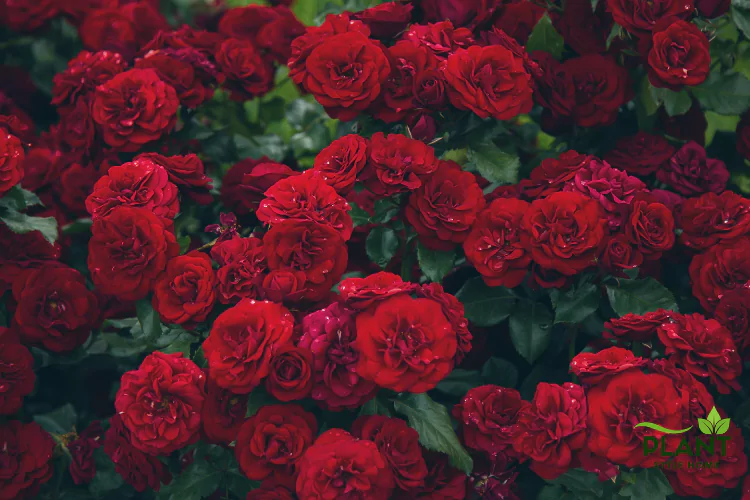
The queen of all flowers, red roses are timeless classics that never go out of style. With their velvety petals and intoxicating fragrance, they’re the gold standard for expressing love and admiration. Roses come in hundreds of varieties, from climbing types to compact bushes perfect for containers.
Did you know? A single red rose means “I love you,” while a dozen represents complete devotion!
| Attribute | Information |
|---|---|
| Origin | Ancient Persia, widely cultivated worldwide |
| Size | 2–6 feet tall (varies by variety) |
| Soil Type | Rich, well-drained loamy soil |
| Sunlight | Full sun (6+ hours daily) |
| Water Needs | Regular watering, keep soil consistently moist |
| Blooming Season | Spring through fall (some all year) |
2: Geraniums (Zonal)
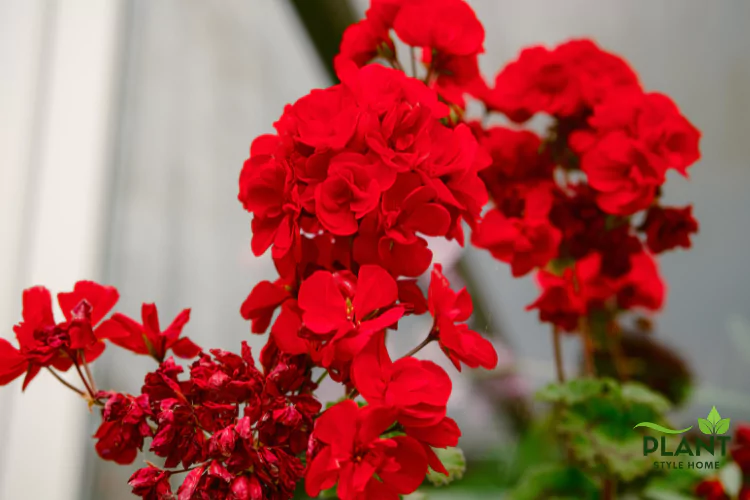
Geraniums are the workhorses of the garden—tough, reliable, and absolutely gorgeous. Their clusters of red blooms sit atop attractive foliage that sometimes features darker zones (hence the name “zonal”). They’re perfect for beginners because they forgive mistakes and keep blooming like champions.
| Attribute | Information |
|---|---|
| Origin | South Africa |
| Size | 12–24 inches tall |
| Soil Type | Well-drained potting mix or garden soil |
| Sunlight | Full sun to partial shade |
| Water Needs | Moderate; let soil dry between waterings |
| Blooming Season | Spring to first frost |
3: Tulips
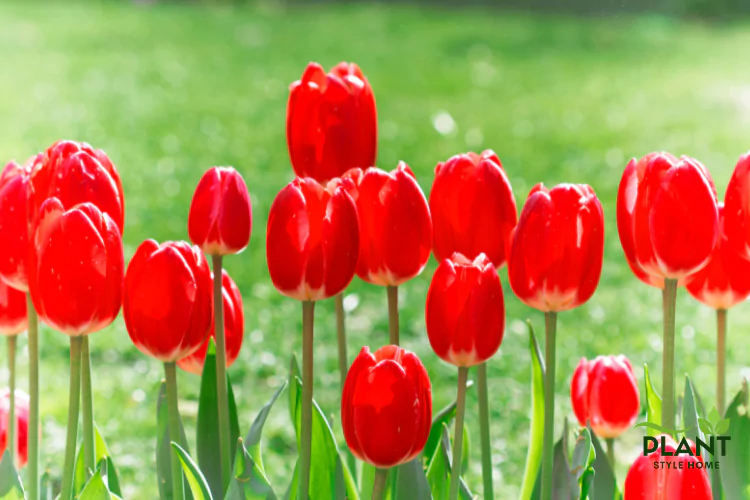
Tulips are spring’s way of showing off! These cheerful bulbs push through cold soil to deliver stunning cup-shaped blooms in the most brilliant red you can imagine. They’re perfect for mass plantings that create a dramatic color sweep across your garden beds.
Plant tulip bulbs in fall for a spectacular spring show!
| Attribute | Information |
|---|---|
| Origin | Central Asia, Netherlands |
| Size | 6–24 inches tall |
| Soil Type | Sandy, well-drained soil |
| Sunlight | Full sun to light shade |
| Water Needs | Moderate during growth; bulbs need dry summer dormancy |
| Blooming Season | Early to mid-spring |
4: Hibiscus
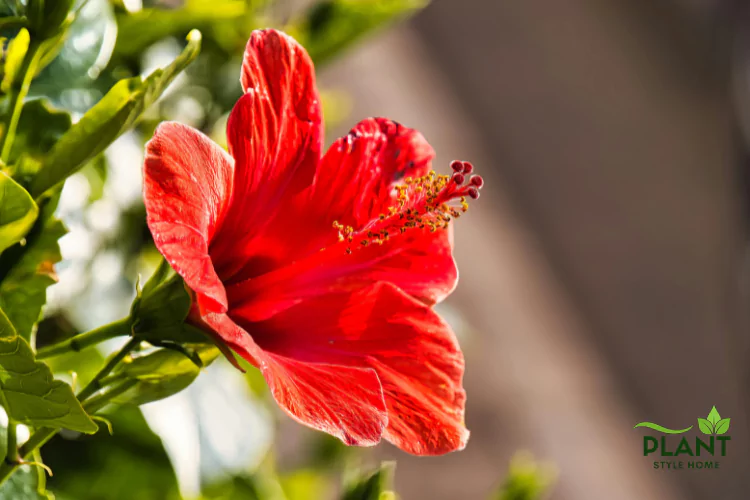
Talk about tropical vibes! Hibiscus flowers are huge, showy, and absolutely stunning in bright red. Each bloom only lasts a day or two, but the plant keeps producing more throughout the season. They’re perfect for creating that vacation feeling right in your backyard.
| Attribute | Information |
|---|---|
| Origin | Tropical and subtropical Asia |
| Size | 3–10 feet tall (varies by type) |
| Soil Type | Rich, well-drained soil |
| Sunlight | Full sun (tropical types); partial shade tolerance varies |
| Water Needs | High; keep consistently moist |
| Blooming Season | Summer through fall |
5: Poinsettias

The star of Christmas, poinsettias bring festive cheer with their brilliant red bracts (those aren’t actually petals—surprise!). While many people treat them as temporary decorations, you can keep these beauties happy year-round with proper care.
| Attribute | Information |
|---|---|
| Origin | Mexico and Guatemala |
| Size | 2–6 feet tall (indoor plants typically smaller) |
| Soil Type | Well-draining, slightly acidic potting soil |
| Sunlight | Bright, indirect light |
| Water Needs | Moderate; water when top inch of soil is dry |
| Blooming Season | Winter (with proper light manipulation) |
6: Dahlias
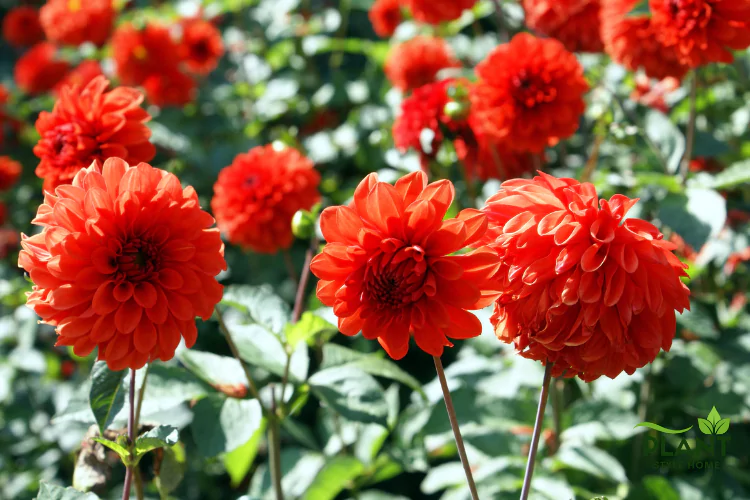
Dahlias are the divas of the garden, and they know it! These stunning flowers come in an incredible range of sizes and forms, from dinner-plate giants to petite pompons. Red dahlias are absolutely eye-catching and make fantastic cut flowers that last for days.
| Attribute | Information |
|---|---|
| Origin | Mexico and Central America |
| Size | 1–6 feet tall |
| Soil Type | Rich, well-drained soil with organic matter |
| Sunlight | Full sun (6–8 hours minimum) |
| Water Needs | Regular deep watering, especially during blooming |
| Blooming Season | Summer through first frost |
7: Carnations
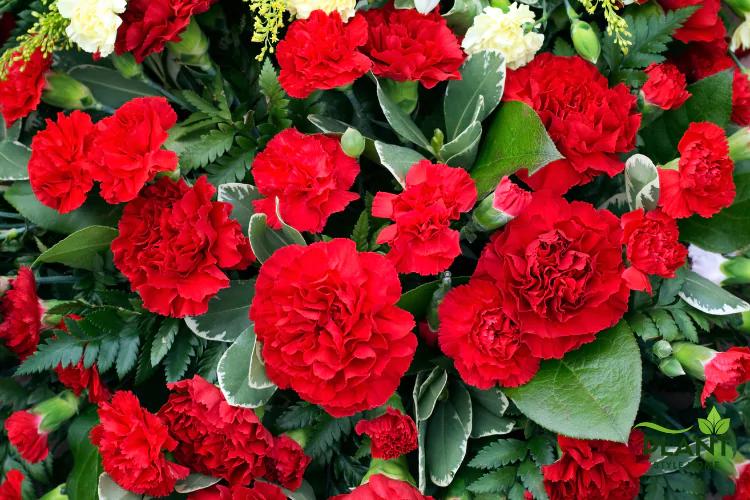
Carnations are seriously underrated! These ruffled beauties last forever as cut flowers and have a lovely spicy-sweet fragrance. They’re super hardy, affordable, and come in the most vibrant red shades. Plus, they’re perfect for both gardens and bouquets.
Carnations can last up to 3 weeks in a vase—talk about value!
| Attribute | Information |
|---|---|
| Origin | Mediterranean region |
| Size | 12–24 inches tall |
| Soil Type | Well-drained, slightly alkaline soil |
| Sunlight | Full sun |
| Water Needs | Moderate; avoid overhead watering |
| Blooming Season | Spring through summer (often reblooms) |
8: Poppies
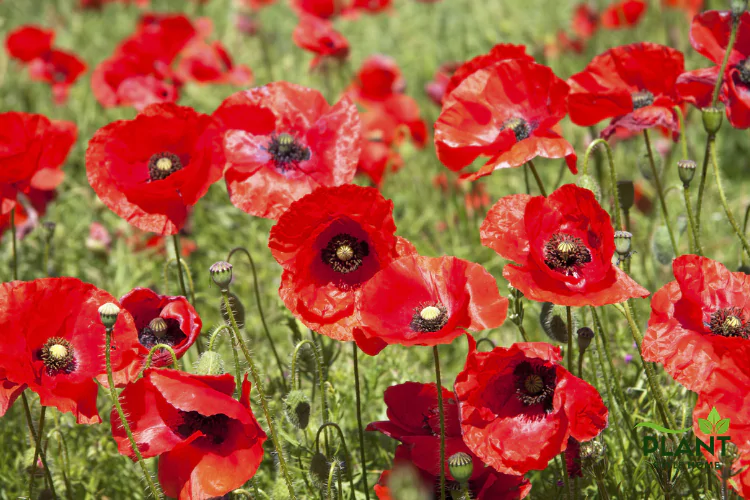
Poppies are wild, free-spirited flowers that dance in the breeze. Their papery petals in brilliant red create dramatic displays that are impossible to ignore. They’re also incredibly easy to grow from seed, making them perfect for casual, cottage-style gardens.
| Attribute | Information |
|---|---|
| Origin | Europe, Asia, North America |
| Size | 1–4 feet tall |
| Soil Type | Well-drained, average to poor soil |
| Sunlight | Full sun |
| Water Needs | Low to moderate; drought-tolerant once established |
| Blooming Season | Late spring to early summer |
9: Begonias
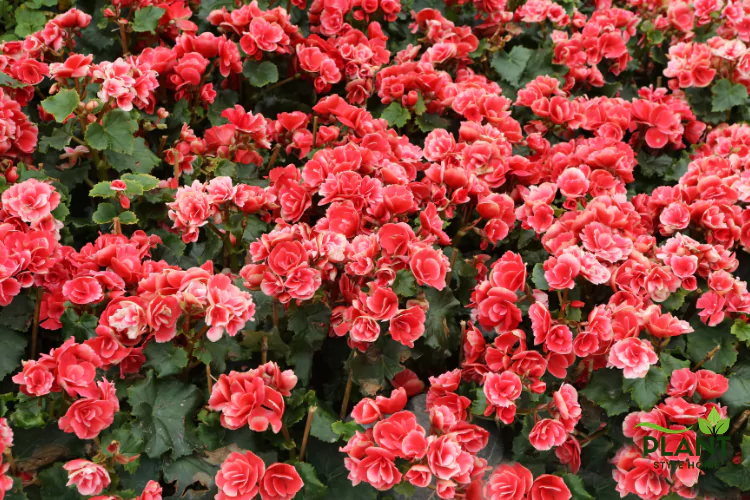
Begonias are shade-loving champions that bring red blooms to those tricky spots where sun-lovers won’t grow. They’re perfect for containers, hanging baskets, or under trees. The bonus? Many varieties have stunning foliage that looks good even when flowers fade.
| Attribute | Information |
|---|---|
| Origin | Tropical and subtropical regions |
| Size | 6–18 inches tall |
| Soil Type | Rich, well-drained potting mix |
| Sunlight | Partial to full shade |
| Water Needs | Moderate; keep evenly moist but not soggy |
| Blooming Season | Spring through fall |
10: Zinnias
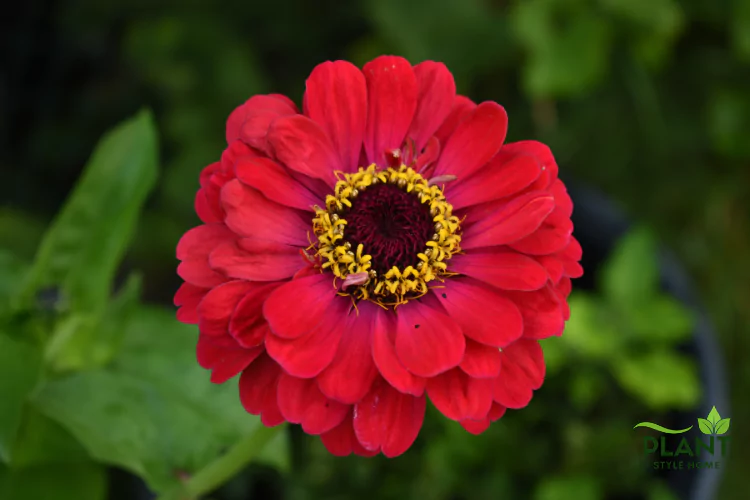
Zinnias are summer superstars that bloom their hearts out in the hottest weather. They’re ridiculously easy to grow from seed, making them perfect for kids’ gardens or beginners. Red zinnias attract butterflies like magnets and look amazing in casual, cottage-style plantings.
| Attribute | Information |
|---|---|
| Origin | Mexico and Central America |
| Size | 6–48 inches tall (varies by variety) |
| Soil Type | Well-drained, moderately fertile soil |
| Sunlight | Full sun |
| Water Needs | Moderate; drought-tolerant once established |
| Blooming Season | Summer through first frost |
11: Gladiolus

Gladiolus are the tall, elegant showstoppers of summer gardens. Their sword-shaped leaves and towering flower spikes covered in red blooms create dramatic vertical interest. They’re also fantastic cut flowers that make impressive arrangements.
The name “gladiolus” comes from the Latin word for sword!
| Attribute | Information |
|---|---|
| Origin | Africa, Mediterranean region, Europe |
| Size | 2–6 feet tall |
| Soil Type | Fertile, well-drained sandy loam |
| Sunlight | Full sun |
| Water Needs | Regular watering during growth |
| Blooming Season | Mid-summer to early fall |
12: Amaryllis
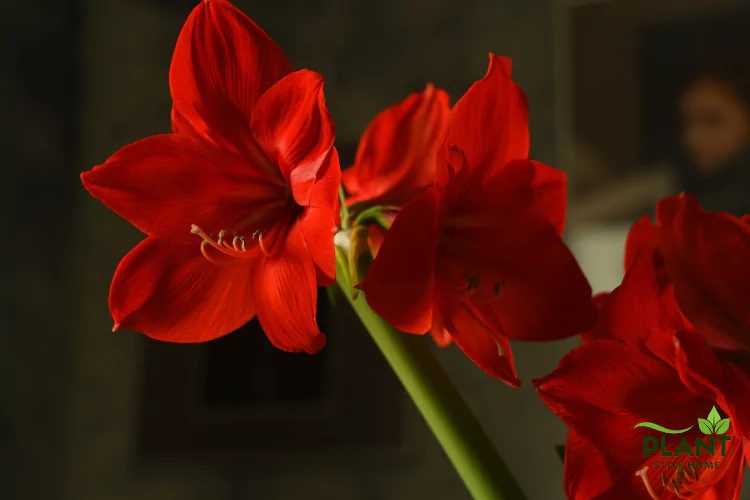
Amaryllis bulbs produce some of the most spectacular red flowers you’ll ever see. These huge, trumpet-shaped blooms appear on tall, sturdy stalks and are often grown indoors as winter gifts. They’re surprisingly easy and can be coaxed to rebloom year after year.
| Attribute | Information |
|---|---|
| Origin | Central and South America |
| Size | 18–24 inches tall |
| Soil Type | Well-drained potting soil |
| Sunlight | Bright, indirect light indoors; partial sun outdoors |
| Water Needs | Moderate; increase as growth begins |
| Blooming Season | Winter to spring (timing depends on planting) |
13: Chrysanthemums (Mums)
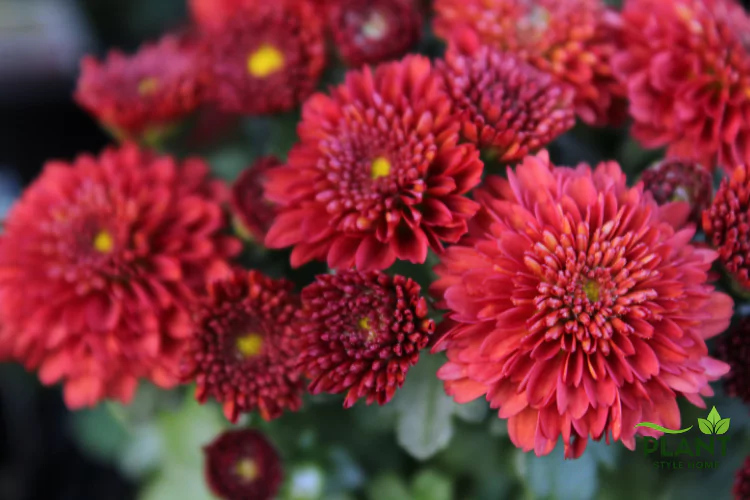
Fall wouldn’t be the same without mums! These hardy perennials explode with color just when most other flowers are calling it quits for the season. Red mums are classic autumn decorations and actually work as perennials in many climates if planted early enough.
| Attribute | Information |
|---|---|
| Origin | China and East Asia |
| Size | 1–3 feet tall |
| Soil Type | Rich, well-drained soil |
| Sunlight | Full sun |
| Water Needs | Regular watering; keep evenly moist |
| Blooming Season | Late summer through fall |
14: Peonies

Peonies are the ultimate romantic flowers with their lush, layered petals and heavenly fragrance. Red peonies are less common than pink or white varieties, making them extra special. These long-lived perennials can bloom in the same spot for decades.
Peonies can live for over 100 years and are often passed down through generations!
| Attribute | Information |
|---|---|
| Origin | China, Europe, North America |
| Size | 2–4 feet tall |
| Soil Type | Rich, well-drained soil |
| Sunlight | Full sun to light shade |
| Water Needs | Regular watering; drought-tolerant once established |
| Blooming Season | Late spring to early summer |
15: Salvia (Scarlet Sage)
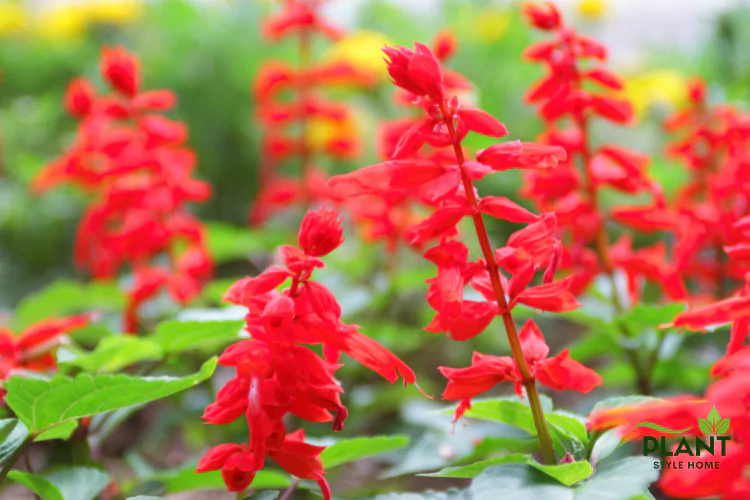
Salvia splendens, or scarlet sage, produces vibrant red flower spikes that hummingbirds absolutely love. These heat-loving annuals bloom continuously all summer long with minimal care. They’re perfect for adding vertical interest to borders and containers.
| Attribute | Information |
|---|---|
| Origin | Brazil, Mexico |
| Size | 12–30 inches tall |
| Soil Type | Well-drained garden soil |
| Sunlight | Full sun to partial shade |
| Water Needs | Moderate; somewhat drought-tolerant |
| Blooming Season | Summer through fall |
16: Canna Lilies
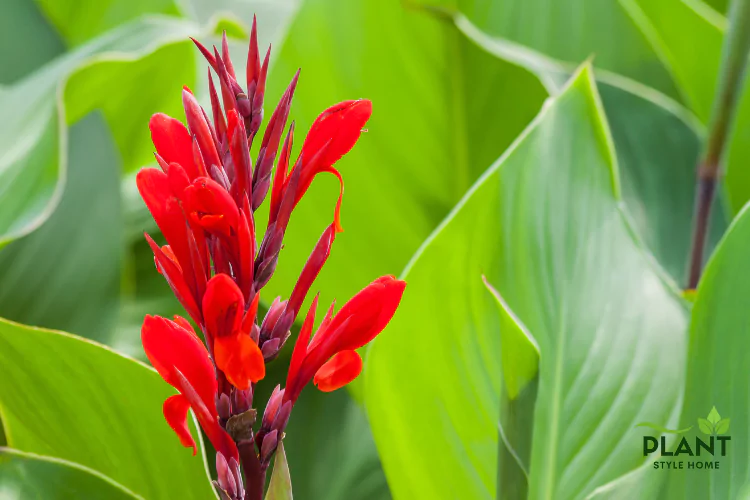
Canna lilies are bold, tropical-looking plants that make a statement with both their flowers and foliage. Red canna flowers are exotic and showy, perfect for creating that “wow” factor in gardens. They’re also surprisingly easy to grow in warm climates.
| Attribute | Information |
|---|---|
| Origin | Tropical and subtropical Americas |
| Size | 3–8 feet tall |
| Soil Type | Rich, moist soil |
| Sunlight | Full sun |
| Water Needs | High; keep consistently moist |
| Blooming Season | Summer through fall |
17: Anthurium

Anthuriums are unique houseplants with glossy, heart-shaped “flowers” (actually modified leaves called spathes) in brilliant red. They’re relatively low-maintenance and bloom for months at a time, making them perfect for adding tropical flair indoors.
| Attribute | Information |
|---|---|
| Origin | Central and South America |
| Size | 12–18 inches tall |
| Soil Type | Well-draining orchid mix or peat-based soil |
| Sunlight | Bright, indirect light |
| Water Needs | Moderate; keep soil lightly moist |
| Blooming Season | Year-round with proper care |
18: Bee Balm (Monarda)
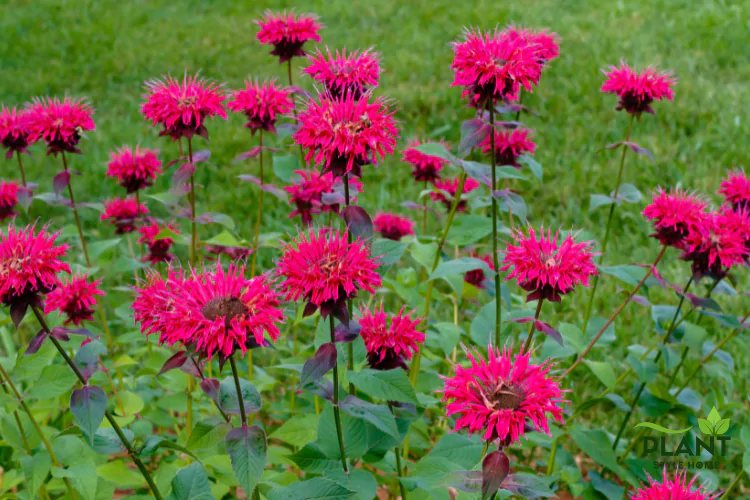
Bee balm lives up to its name, bees, butterflies, and hummingbirds can’t resist it! The shaggy red flowers have a distinctive shape and a lovely minty fragrance. This native wildflower is perfect for pollinator gardens and naturalized areas.
| Attribute | Information |
|---|---|
| Origin | North America |
| Size | 2–4 feet tall |
| Soil Type | Moist, well-drained soil |
| Sunlight | Full sun to partial shade |
| Water Needs | Regular watering; prefers consistent moisture |
| Blooming Season | Mid to late summer |
19: Ranunculus
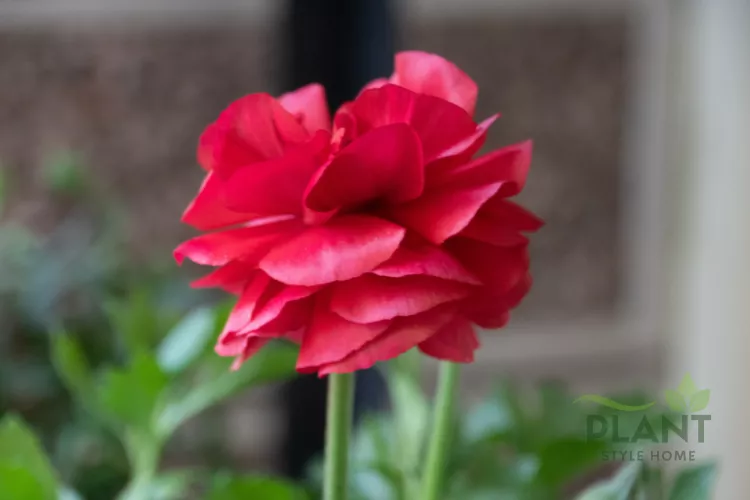
Ranunculus flowers look almost too perfect to be real with their tightly layered petals that resemble roses. Red ranunculus are stunning in arrangements and add elegance to spring gardens. They’re grown from small corms and prefer cool weather.
| Attribute | Information |
|---|---|
| Origin | Mediterranean region, Asia |
| Size | 12–18 inches tall |
| Soil Type | Well-drained, fertile soil |
| Sunlight | Full sun to partial shade |
| Water Needs | Regular watering during growth |
| Blooming Season | Spring to early summer |
20: Gerbera Daisies

Gerbera daisies are pure happiness in flower form! Their large, cheerful blooms with bold petals radiating from a central disk are impossible not to love. Red gerberas are particularly striking and make long-lasting cut flowers.
Gerbera daisies are one of the most popular cut flowers worldwide!
| Attribute | Information |
|---|---|
| Origin | South Africa, Asia |
| Size | 8–24 inches tall |
| Soil Type | Well-drained, sandy loam |
| Sunlight | Full sun to partial shade |
| Water Needs | Moderate; avoid overwatering |
| Blooming Season | Spring through fall |
21: Cardinal Flower
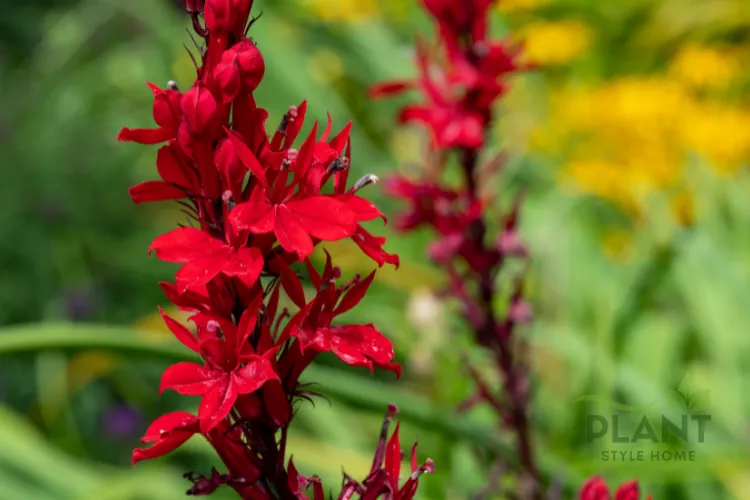
This native wildflower gets its name from the brilliant red robes worn by Catholic cardinals. Cardinal flowers love wet conditions and are perfect for rain gardens or pond edges. Hummingbirds travel miles to visit these stunning red spikes.
| Attribute | Information |
|---|---|
| Origin | North America |
| Size | 2–4 feet tall |
| Soil Type | Moist to wet, rich soil |
| Sunlight | Full sun to partial shade |
| Water Needs | High; thrives in consistently wet conditions |
| Blooming Season | Late summer to fall |
22: Bleeding Heart
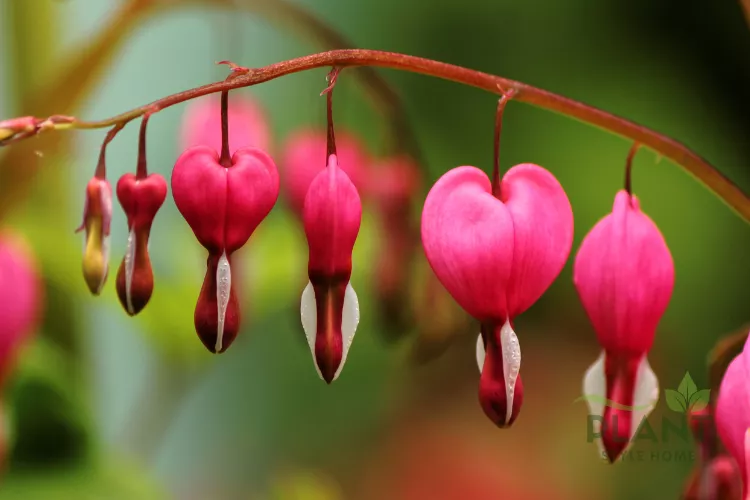
Bleeding heart flowers are whimsical and romantic with their dangling, heart-shaped blooms. While pink is more common, red varieties are absolutely stunning. These woodland plants prefer shady spots and make gorgeous additions to shade gardens.
| Attribute | Information |
|---|---|
| Origin | Asia, North America |
| Size | 2–3 feet tall |
| Soil Type | Rich, moist, well-drained soil |
| Sunlight | Partial to full shade |
| Water Needs | Regular watering; keep soil consistently moist |
| Blooming Season | Spring to early summer |
23: Camellia
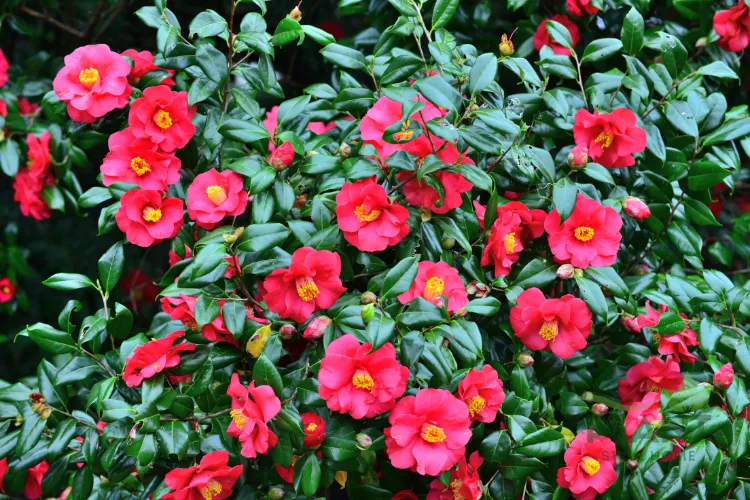
Camellias are elegant shrubs that bloom when most other plants are dormant. Their perfect, rose-like red flowers appear in winter or early spring, bringing unexpected color to cold-season gardens. They’re also prized for their glossy evergreen foliage.
| Attribute | Information |
|---|---|
| Origin | Eastern and Southern Asia |
| Size | 6–12 feet tall (varies by variety) |
| Soil Type | Acidic, well-drained, organic-rich soil |
| Sunlight | Partial shade |
| Water Needs | Regular watering; keep evenly moist |
| Blooming Season | Fall, winter, or spring (depends on variety) |
24: Snapdragons
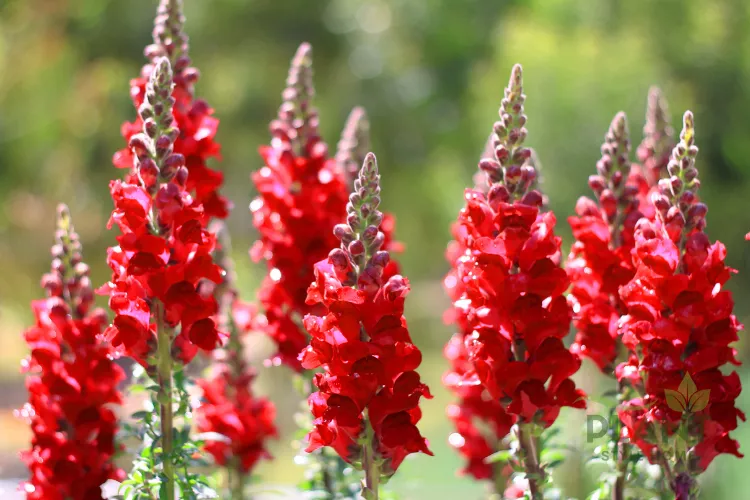
Snapdragons are charming cottage garden favorites with flowers that kids love to “snap” open and shut. Red snapdragons bring vertical interest and old-fashioned charm to beds and borders. They prefer cool weather and often rebloom in fall.
| Attribute | Information |
|---|---|
| Origin | Mediterranean region |
| Size | 6–36 inches tall (varies by variety) |
| Soil Type | Rich, well-drained soil |
| Sunlight | Full sun to partial shade |
| Water Needs | Regular watering; keep evenly moist |
| Blooming Season | Spring to early summer; fall in warm climates |
25: Calla Lilies

Calla lilies are sophisticated and modern-looking with their smooth, trumpet-shaped blooms. Red callas are dramatic and elegant, perfect for contemporary gardens or floral arrangements. Despite the name, they’re not true lilies at all!
Warning: All parts of calla lilies are toxic to pets and humans if ingested.
| Attribute | Information |
|---|---|
| Origin | South Africa |
| Size | 18–36 inches tall |
| Soil Type | Rich, moist, well-drained soil |
| Sunlight | Full sun to partial shade |
| Water Needs | Regular watering during growth; reduce after blooming |
| Blooming Season | Late spring to summer |
26: Freesia
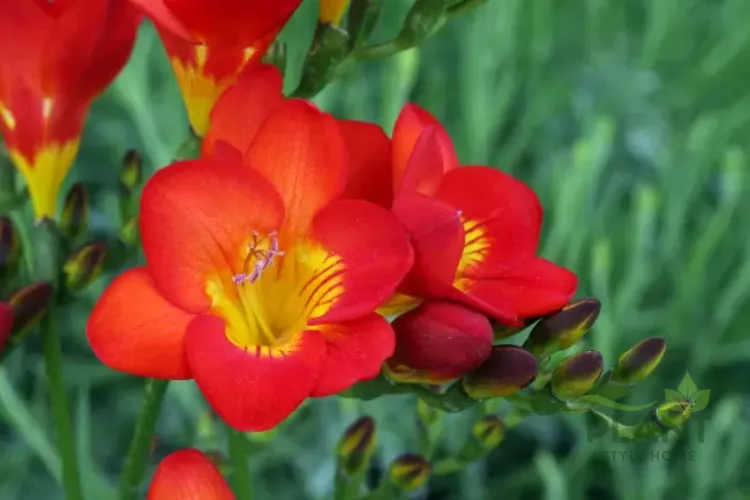
Freesias are beloved for their incredible fragrance that fills entire rooms. These delicate-looking flowers growing from corms produce sweetly scented red blooms perfect for cutting. They’re often grown in greenhouses but thrive outdoors in mild climates.
| Attribute | Information |
|---|---|
| Origin | South Africa |
| Size | 12–18 inches tall |
| Soil Type | Well-drained, sandy soil |
| Sunlight | Full sun to partial shade |
| Water Needs | Regular watering during growth; reduce after blooming |
| Blooming Season | Spring (late winter to early spring in mild climates) |
27: Impatiens (New Guinea)
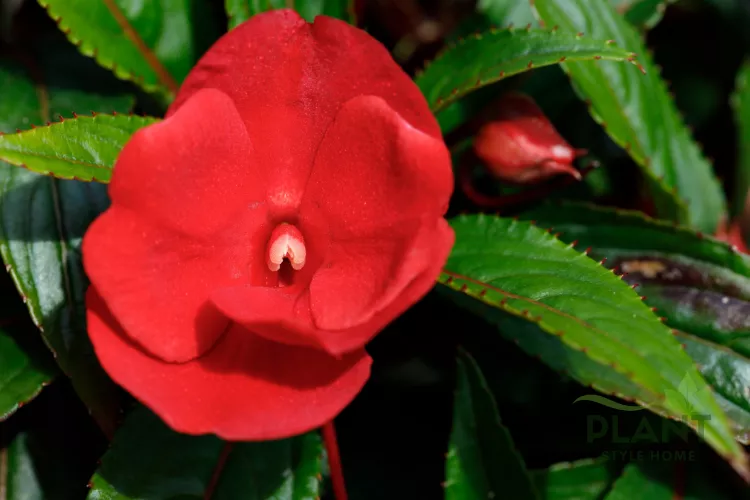
New Guinea impatiens are shade lovers that bloom continuously with almost no effort. Red varieties bring bold color to shady spots where most flowers struggle. They’re perfect for containers, hanging baskets, and shaded garden beds.
| Attribute | Information |
|---|---|
| Origin | New Guinea, Solomon Islands |
| Size | 10–24 inches tall |
| Soil Type | Rich, well-drained potting mix |
| Sunlight | Partial to full shade |
| Water Needs | Regular watering; keep consistently moist |
| Blooming Season | Spring through fall |
28: Asiatic Lilies
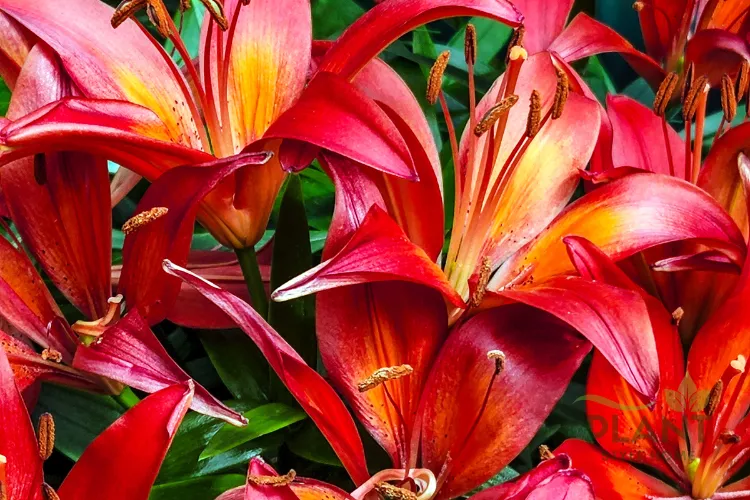
Asiatic lilies are among the easiest true lilies to grow and produce stunning upward-facing blooms. Red Asiatics are bold and beautiful, creating spectacular color in early summer gardens. They grow from bulbs and multiply over time.
| Attribute | Information |
|---|---|
| Origin | Asia |
| Size | 2–5 feet tall |
| Soil Type | Well-drained, slightly acidic soil |
| Sunlight | Full sun to partial shade |
| Water Needs | Regular watering; keep soil evenly moist |
| Blooming Season | Early to mid-summer |
29: Columbine
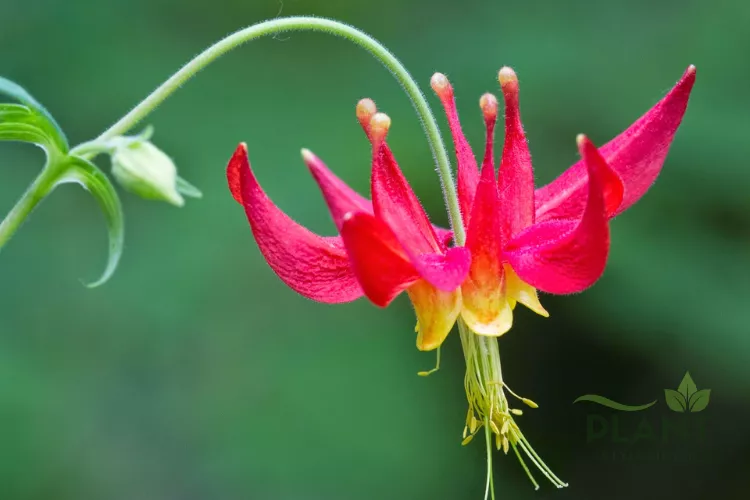
Columbines are delicate woodland flowers with unique spurred petals that seem to float above ferny foliage. Red columbines attract hummingbirds and add graceful charm to shade gardens. They readily self-seed, creating naturalized colonies over time.
| Attribute | Information |
|---|---|
| Origin | North America, Europe, Asia |
| Size | 1–3 feet tall |
| Soil Type | Well-drained, moderately fertile soil |
| Sunlight | Partial shade to full sun |
| Water Needs | Moderate; tolerates some drought |
| Blooming Season | Late spring to early summer |
30: Blanket Flower (Gaillardia)
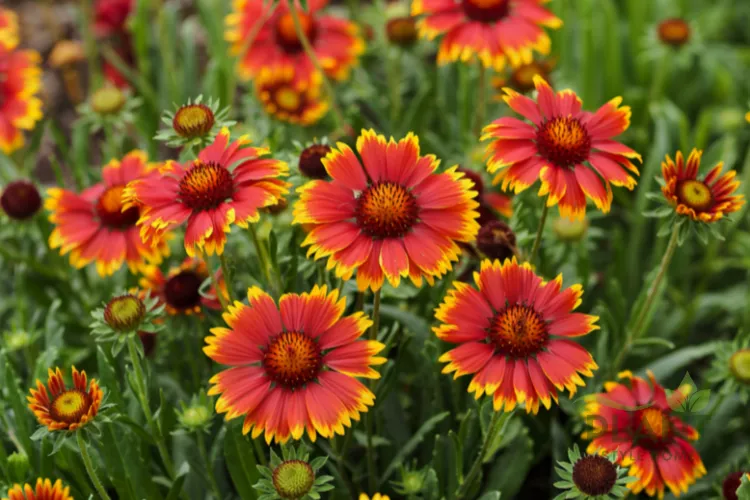
Blanket flowers are tough-as-nails perennials that laugh at heat and drought. Red and yellow bicolor varieties are most common, but solid red forms exist too. They bloom for months and attract tons of butterflies while requiring almost zero maintenance.
| Attribute | Information |
|---|---|
| Origin | North and South America |
| Size | 12–24 inches tall |
| Soil Type | Well-drained, average to poor soil |
| Sunlight | Full sun |
| Water Needs | Low; drought-tolerant once established |
| Blooming Season | Summer through fall |
31: Celosia
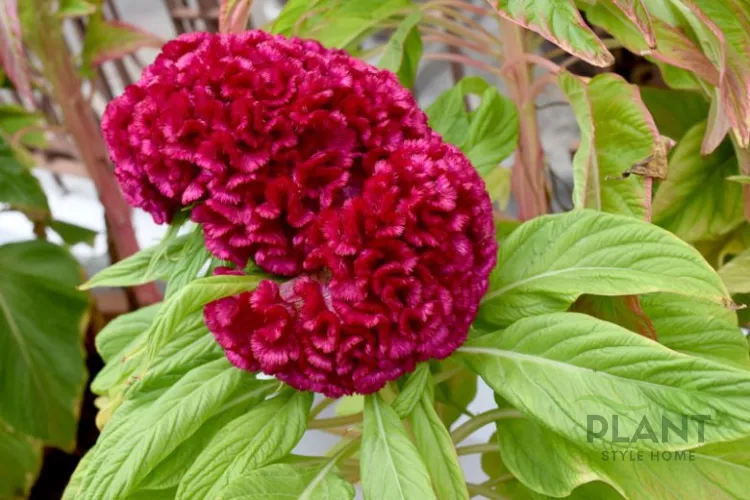
Celosia flowers come in fantastic forms—from feathery plumes to brain-like crested types. Red celosia varieties are incredibly vibrant and hold their color even in hot sun. They’re heat-loving annuals that thrive when other flowers wilt.
Celosia flowers retain their color when dried, making them perfect for everlasting arrangements!
| Attribute | Information |
|---|---|
| Origin | Tropical regions of Africa, Asia, Americas |
| Size | 6–36 inches tall (varies by type) |
| Soil Type | Well-drained, moderately fertile soil |
| Sunlight | Full sun |
| Water Needs | Moderate; somewhat drought-tolerant |
| Blooming Season | Summer through fall |
32: Hollyhocks
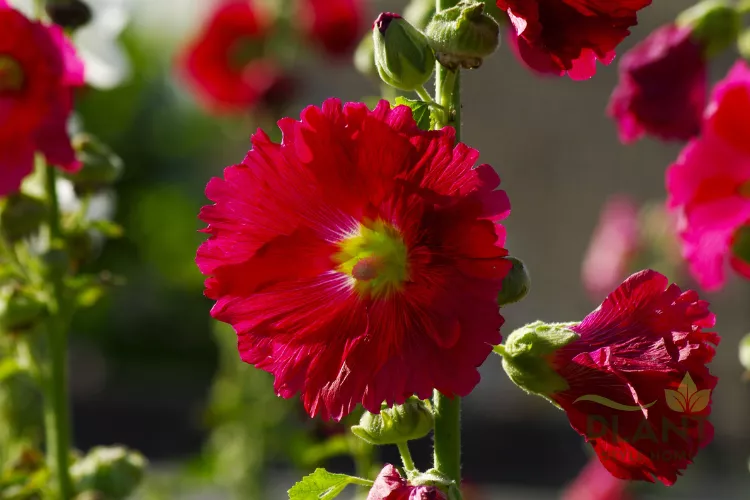
Hollyhocks are old-fashioned cottage garden giants that create dramatic vertical displays. Red hollyhocks tower over gardens with their tall spikes covered in large, tissue-paper flowers. They’re biennials or short-lived perennials that readily self-seed.
| Attribute | Information |
|---|---|
| Origin | Asia, Europe |
| Size | 5–9 feet tall |
| Soil Type | Well-drained, average to rich soil |
| Sunlight | Full sun |
| Water Needs | Regular watering; somewhat drought-tolerant |
| Blooming Season | Mid to late summer |
33: Red Hot Poker

Red hot pokers are architectural plants with exotic-looking flower spikes that really do look like glowing pokers. These dramatic perennials are hummingbird magnets and create bold focal points in gardens. They’re surprisingly cold-hardy despite their tropical appearance.
| Attribute | Information |
|---|---|
| Origin | South Africa |
| Size | 2–5 feet tall |
| Soil Type | Well-drained, average soil |
| Sunlight | Full sun |
| Water Needs | Moderate; drought-tolerant once established |
| Blooming Season | Summer to fall |
34: Mandevilla
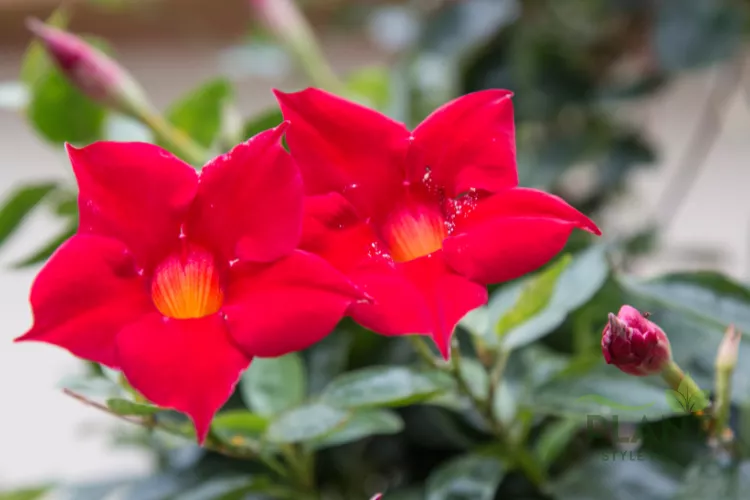
Mandevilla is a tropical vine that produces gorgeous trumpet-shaped red flowers all summer long. It’s perfect for trellises, arbors, or hanging baskets where its cascading stems can show off. In cold climates, it’s grown as an annual or brought indoors for winter.
| Attribute | Information |
|---|---|
| Origin | Central and South America |
| Size | 10–20 feet (as climbing vine) |
| Soil Type | Rich, well-drained potting mix |
| Sunlight | Full sun to partial shade |
| Water Needs | Regular watering; keep evenly moist |
| Blooming Season | Spring through fall |
35: Verbena
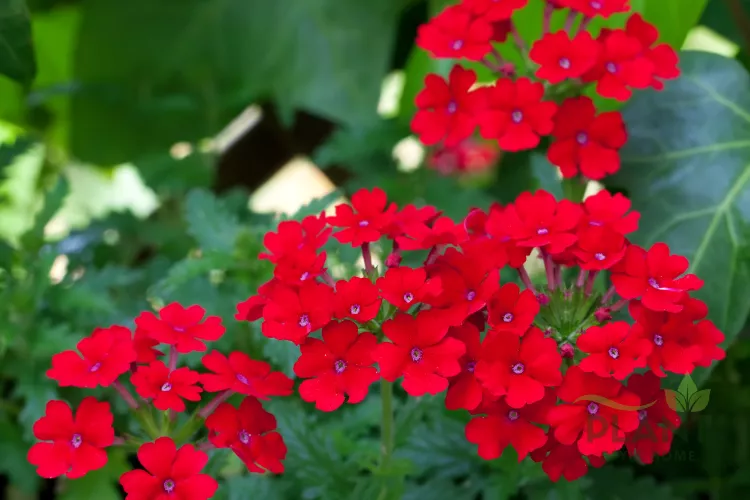
Verbena is a hardworking spreading plant that covers ground or spills from containers with clusters of small red flowers. It blooms continuously with minimal deadheading and attracts butterflies like crazy. It’s heat and drought tolerant once established.
| Attribute | Information |
|---|---|
| Origin | North and South America |
| Size | 6–18 inches tall, spreading habit |
| Soil Type | Well-drained, average soil |
| Sunlight | Full sun |
| Water Needs | Moderate; drought-tolerant once established |
| Blooming Season | Spring through fall |
36: Dianthus

Dianthus, also called pinks or sweet william, produces cheerful red blooms with fringed petals and a spicy-sweet fragrance. These compact perennials are perfect for edging paths, rock gardens, or container combinations. They prefer cool weather and often rebloom in fall.
| Attribute | Information |
|---|---|
| Origin | Europe, Asia |
| Size | 6–18 inches tall |
| Soil Type | Well-drained, slightly alkaline soil |
| Sunlight | Full sun |
| Water Needs | Moderate; avoid overwatering |
| Blooming Season | Spring to early summer; may rebloom |
37: Azaleas
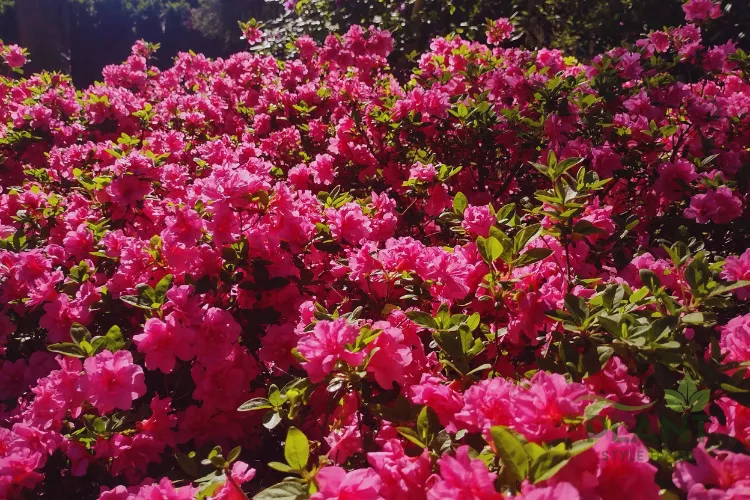
Azaleas are spring-blooming shrubs that put on spectacular shows when they’re covered in red blooms. These acid-loving plants come in both deciduous and evergreen types. They’re perfect for creating dramatic color in woodland gardens or foundation plantings.
| Attribute | Information |
|---|---|
| Origin | Asia, North America |
| Size | 2–8 feet tall (varies greatly by variety) |
| Soil Type | Acidic, well-drained, organic-rich soil |
| Sunlight | Partial shade to filtered sun |
| Water Needs | Regular watering; keep evenly moist |
| Blooming Season | Spring (some varieties bloom fall or winter) |
38: Petunias

Petunias are the workhorses of summer gardens and containers. Red petunias bloom their heads off from spring until frost with minimal care. Modern varieties are more heat and rain tolerant than ever, making them even easier to grow successfully.
| Attribute | Information |
|---|---|
| Origin | South America |
| Size | 6–18 inches tall (trailing types spread wider) |
| Soil Type | Well-drained, fertile soil |
| Sunlight | Full sun |
| Water Needs | Regular watering; somewhat drought-tolerant |
| Blooming Season | Spring through fall |
39: Cockscomb
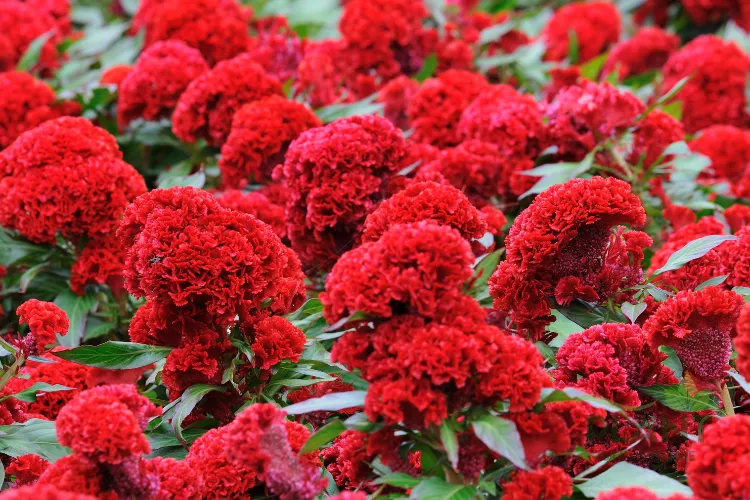
Cockscomb is a type of celosia with bizarrely beautiful crested flowers that really do look like rooster combs. Red varieties are particularly striking and create conversation-starting displays. These heat-lovers thrive when most other annuals are struggling in summer sun.
| Attribute | Information |
|---|---|
| Origin | Tropical regions |
| Size | 6–36 inches tall |
| Soil Type | Well-drained, moderately fertile soil |
| Sunlight | Full sun |
| Water Needs | Moderate; somewhat drought-tolerant |
| Blooming Season | Summer through fall |
40: Anemones

Anemones are graceful flowers with delicate petals surrounding dramatic dark centers. Red anemones are stunning in spring gardens or as cut flowers. They grow from small corms and naturalize easily in the right conditions.
The name “anemone” comes from the Greek word for wind—they’re often called windflowers!
| Attribute | Information |
|---|---|
| Origin | Mediterranean region, worldwide temperate zones |
| Size | 6–24 inches tall (varies by species) |
| Soil Type | Well-drained, organic-rich soil |
| Sunlight | Full sun to partial shade |
| Water Needs | Regular watering during growth |
| Blooming Season | Spring or fall (depends on species) |
41: Calibrachoa (Million Bells)
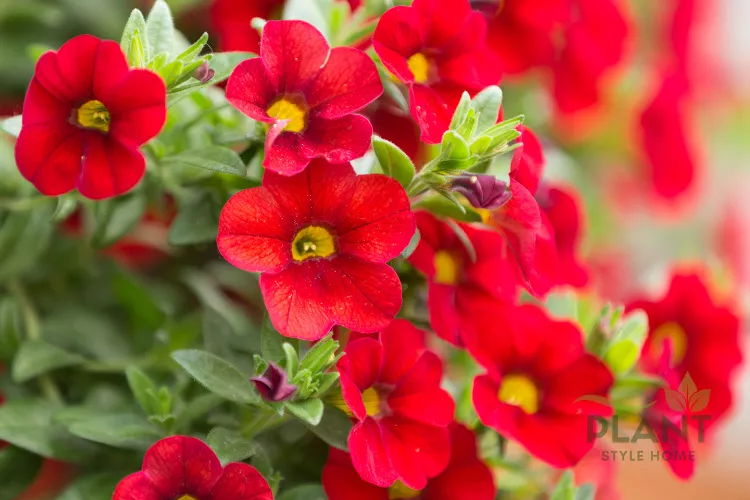
Calibrachoa looks like miniature petunias and blooms continuously with tiny red bells. These trailing plants are perfect for hanging baskets and containers where they spill over edges beautifully. They’re low-maintenance and self-cleaning (no deadheading needed!).
| Attribute | Information |
|---|---|
| Origin | South America |
| Size | 3–9 inches tall, trailing habit |
| Soil Type | Well-drained potting mix |
| Sunlight | Full sun |
| Water Needs | Regular watering; keep evenly moist |
| Blooming Season | Spring through fall |
42: Crocosmia
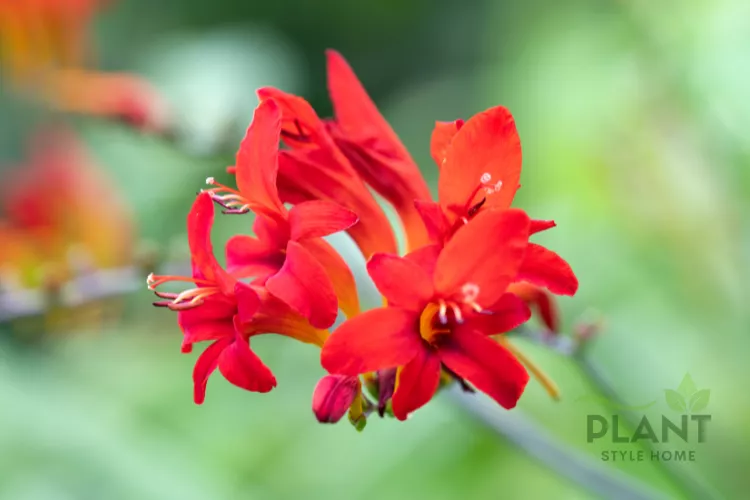
Crocosmia produces arching stems lined with bright red tubular flowers that hummingbirds adore. These easy-care perennials spread from corms and create dramatic clumps over time. Their sword-shaped foliage adds texture even when not in bloom.
| Attribute | Information |
|---|---|
| Origin | South Africa |
| Size | 2–4 feet tall |
| Soil Type | Well-drained, moderately fertile soil |
| Sunlight | Full sun to partial shade |
| Water Needs | Regular watering during growth |
| Blooming Season | Mid to late summer |
43: Fuchsia
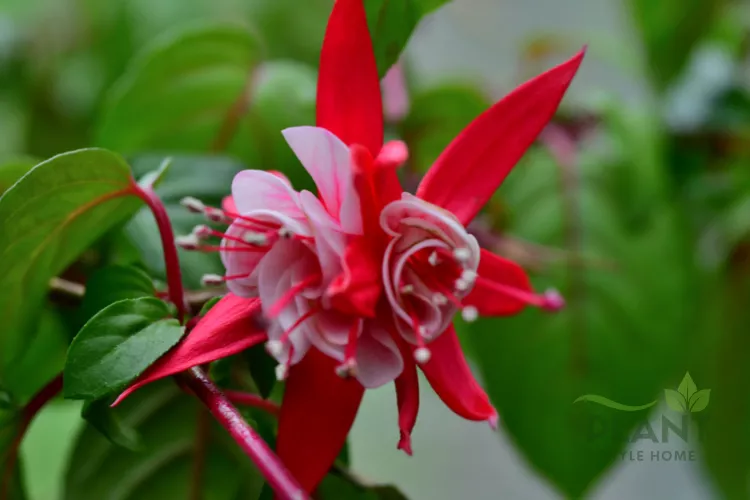
Fuchsias are elegant shade-lovers with dangling flowers that look like ballerinas. Red varieties are classic and beautiful in hanging baskets or shaded containers. They prefer cool, humid conditions and bloom continuously when happy.
| Attribute | Information |
|---|---|
| Origin | Central and South America |
| Size | 1–3 feet tall (varies by variety) |
| Soil Type | Rich, well-drained potting mix |
| Sunlight | Partial to full shade |
| Water Needs | Regular watering; keep consistently moist |
| Blooming Season | Spring through fall |
44: Sweet Peas
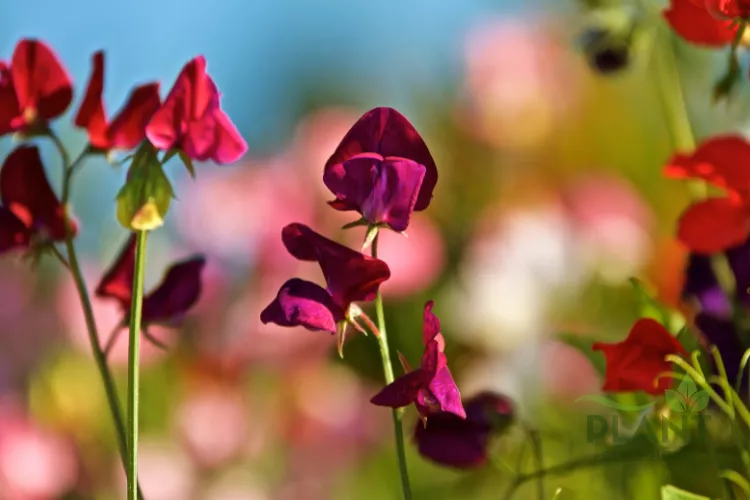
Sweet peas are old-fashioned climbing annuals with ruffled flowers and an intoxicating fragrance. Red sweet peas are less common but absolutely gorgeous. They prefer cool weather and are perfect for cutting gardens—the more you cut them, the more they bloom!
Sweet peas were introduced to England in 1699 and have been garden favorites ever since!
| Attribute | Information |
|---|---|
| Origin | Sicily, Southern Italy |
| Size | 6–8 feet (climbing varieties) |
| Soil Type | Rich, well-drained soil |
| Sunlight | Full sun |
| Water Needs | Regular watering; keep soil moist |
| Blooming Season | Spring to early summer (cool season) |
45: Red Valerian
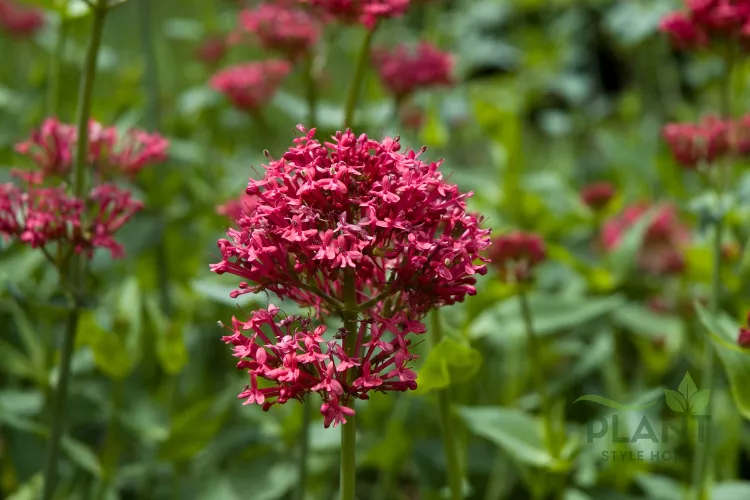
Red valerian is a tough, drought-tolerant perennial that thrives where many plants struggle. It produces clusters of small red flowers on tall stems and readily self-seeds. It’s perfect for rock gardens, slopes, or Mediterranean-style landscapes.
| Attribute | Information |
|---|---|
| Origin | Mediterranean region |
| Size | 2–3 feet tall |
| Soil Type | Well-drained, even poor or rocky soil |
| Sunlight | Full sun |
| Water Needs | Low; very drought-tolerant |
| Blooming Season | Late spring through summer |
46: Stock
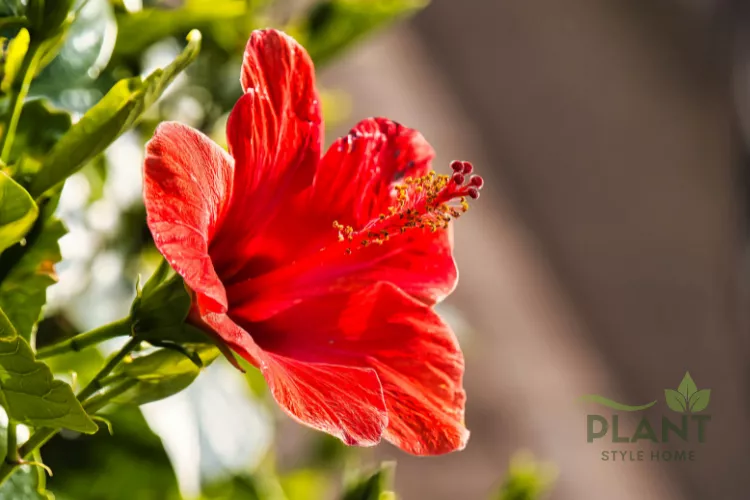
Stock flowers produce dense spikes of fragrant blooms that fill gardens with their spicy-sweet scent. Red stock varieties are romantic and old-fashioned, perfect for cutting gardens. These cool-season annuals prefer spring or fall weather in most climates.
| Attribute | Information |
|---|---|
| Origin | Mediterranean region |
| Size | 12–30 inches tall |
| Soil Type | Rich, well-drained soil |
| Sunlight | Full sun to partial shade |
| Water Needs | Regular watering; keep evenly moist |
| Blooming Season | Spring (or winter in mild climates) |
47: Alstroemeria (Peruvian Lily)

Alstroemeria produces clusters of lily-like flowers with beautiful markings and stripes. Red varieties are stunning and make excellent long-lasting cut flowers. These rhizomatous perennials bloom for months and spread to form nice clumps.
| Attribute | Information |
|---|---|
| Origin | South America (Peru, Chile, Brazil) |
| Size | 1–3 feet tall |
| Soil Type | Well-drained, fertile soil |
| Sunlight | Full sun to partial shade |
| Water Needs | Regular watering during growth |
| Blooming Season | Spring through summer (often longer) |
48: Lisianthus
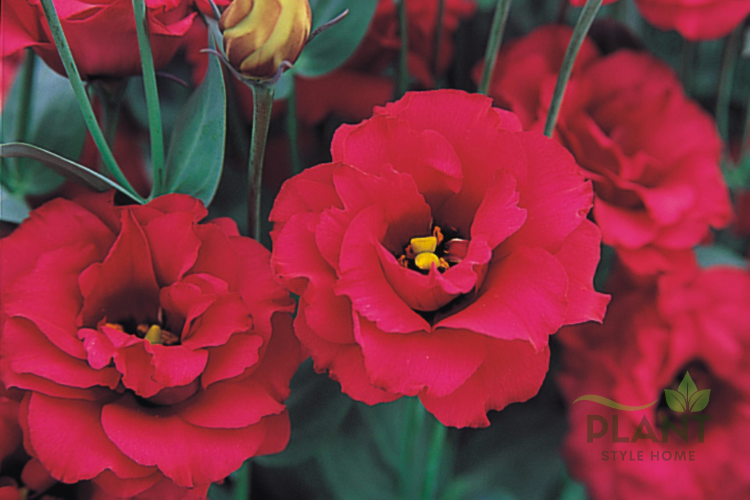
Lisianthus looks like roses and peonies had a baby! These elegant flowers with ruffled petals are favorites among florists. Red lisianthus varieties are sophisticated and romantic, perfect for special bouquets or containers.
| Attribute | Information |
|---|---|
| Origin | Southern United States, Mexico, Caribbean |
| Size | 12–24 inches tall |
| Soil Type | Well-drained, neutral to slightly alkaline soil |
| Sunlight | Full sun to partial shade |
| Water Needs | Regular watering; keep evenly moist |
| Blooming Season | Summer to fall |
49: Bottle Brush
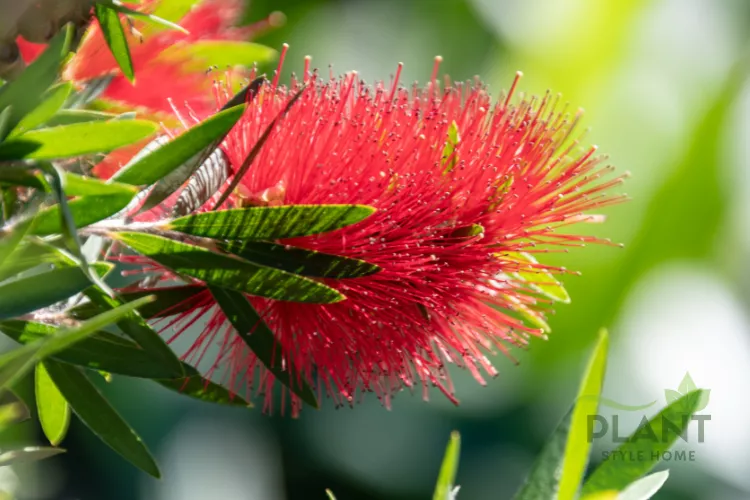
Bottle brush plants produce unique cylindrical flower spikes that really do look like brushes for cleaning bottles! Red varieties are most common and absolutely loved by hummingbirds. These evergreen shrubs bring year-round interest to warm climate gardens.
| Attribute | Information |
|---|---|
| Origin | Australia |
| Size | 3–15 feet tall (varies by species) |
| Soil Type | Well-drained, slightly acidic soil |
| Sunlight | Full sun |
| Water Needs | Moderate; drought-tolerant once established |
| Blooming Season | Spring and summer (often sporadically year-round)50: |
50: Penstemon
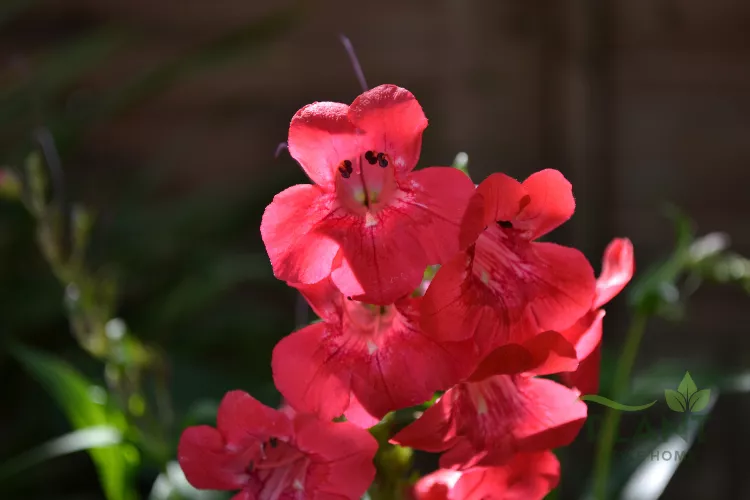
Penstemon, or beardtongue, produces tubular red flowers on tall spikes that hummingbirds can’t resist. These native perennials are drought-tolerant once established and come in varieties suitable for many different climates. They’re perfect for waterwise gardens.
| Attribute | Information |
|---|---|
| Origin | North America |
| Size | 1–3 feet tall (varies by species) |
| Soil Type | Well-drained, sandy or rocky soil |
| Sunlight | Full sun to partial shade |
| Water Needs | Low to moderate; drought-tolerant |
| Blooming Season | Late spring to summer |
51: Red Spider Lily
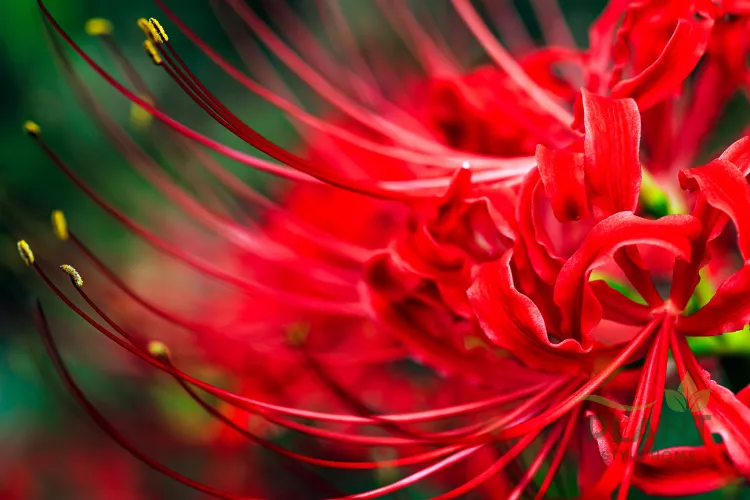
Red spider lilies are dramatic and mysterious with their spidery petals and unusual blooming habit. They typically bloom in late summer or fall on bare stems before foliage appears. These striking bulbs are perfect for creating late-season interest.
In Japanese culture, red spider lilies are associated with death and the afterlife and are often planted near graves.
| Attribute | Information |
|---|---|
| Origin | China, Korea, Nepal, Japan |
| Size | 12–24 inches tall |
| Soil Type | Well-drained, rich soil |
| Sunlight | Full sun to partial shade |
| Water Needs | Regular watering during growth; dry dormancy in summer |
| Blooming Season | Late summer to fall |
52: Nasturtium
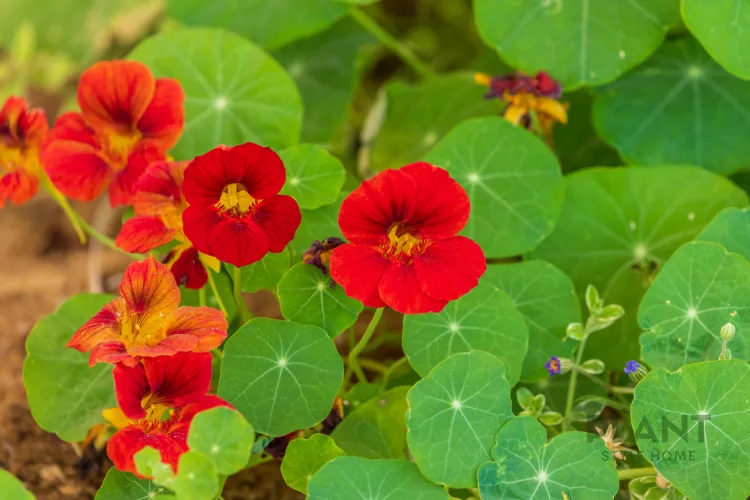
Nasturtiums are cheerful, easy-to-grow flowers with round leaves and bright red blooms. The best part? Both the flowers and leaves are edible with a peppery taste! They’re perfect for beginner gardeners and attract beneficial insects.
| Attribute | Information |
|---|---|
| Origin | Central and South America |
| Size | 6–12 inches tall (climbing types trail or climb) |
| Soil Type | Average to poor soil (too rich reduces flowering) |
| Sunlight | Full sun to partial shade |
| Water Needs | Moderate; drought-tolerant once established |
| Blooming Season | Summer through fall |
Essential Care Tips for Red Flowers
Growing gorgeous red flowers doesn’t have to be complicated! Here are some practical tips that’ll help you succeed:
General Care Basics:
- Start with healthy plants – Choose plants with vibrant foliage and lots of buds rather than those already in full bloom. They’ll establish better and bloom longer.
- Feed regularly – Most flowering plants are heavy feeders. Use a balanced fertilizer or one higher in phosphorus (the middle number) to encourage more blooms.
- Deadhead spent blooms – Removing faded flowers encourages plants to produce more blooms instead of putting energy into seed production. This simple task can extend your flowering season by weeks!
- Water properly – Most red flowers prefer consistent moisture but hate soggy soil. Water deeply but less frequently rather than shallow daily watering.
- Mulch around plants – A 2-3 inch layer of mulch keeps soil moist, suppresses weeds, and regulates temperature. Just keep it away from plant stems to prevent rot.
Seasonal Care:
- Spring – This is planting time for most flowers! Prepare beds with compost, start fertilizing, and keep an eye out for pests just emerging from winter dormancy.
- Summer – Water deeply during heat waves, deadhead regularly, and watch for stressed plants that might need afternoon shade or more water.
- Fall – Plant spring bulbs now, divide overgrown perennials, and collect seeds from favorites. Don’t cut back perennials too early—wait until after frost.
- Winter – Protect tender plants with mulch or bring them indoors. Plan next year’s garden and order seeds while relaxing with plant catalogs!
Pest and Disease Prevention:
- Encourage beneficial insects – Plant herbs and native flowers to attract ladybugs, lacewings, and other helpful bugs that eat pests.
- Improve air circulation – Space plants properly and thin overcrowded growth to prevent fungal diseases like powdery mildew.
- Inspect regularly – Catch problems early by checking plants weekly. Remove damaged leaves and treat issues before they spread.
- Use organic solutions first – Try handpicking pests, using insecticidal soap, or neem oil before reaching for harsh chemicals.
How to Choose the Right Red Flowers for Your Garden
With so many gorgeous red flowers available, how do you pick the right ones? Consider these factors:
Climate and Hardiness Zone
Your USDA hardiness zone determines which perennials will survive winter in your area. Don’t fall in love with a plant that can’t handle your climate! Check plant tags for zone information and stick with plants rated for your zone or colder. Annuals work anywhere since you replant them each year.
Light Conditions
Assess how much sun your planting area gets:
- Full sun means 6+ hours of direct sunlight daily
- Partial shade means 3-6 hours of sun
- Full shade means less than 3 hours of direct sun
Most red flowers love full sun, but there are beautiful shade-tolerant options like begonias, impatiens, and fuchsias.
Space and Mature Size
Consider both height and spread. That cute little plant might grow into a 6-foot giant! Read tags carefully and plan for mature size. Tall flowers work great in back borders but might overwhelm small containers.
Bloom Time
Create a garden with continuous color by mixing flowers that bloom at different times:
- Early spring: Tulips, ranunculus
- Late spring/early summer: Peonies, roses, snapdragons
- Summer: Zinnias, dahlias, hibiscus, salvias
- Fall: Mums, asters, cannas
Maintenance Level
Be honest about how much time you can devote to gardening:
- Low maintenance: Zinnias, geraniums, coneflowers, sedums
- Medium maintenance: Roses, dahlias, petunias
- Higher maintenance: Hybrid tea roses, tuberous begonias
Water Requirements
Match plants to your watering situation:
- Drought-tolerant: Blanket flowers, poppies, verbena, red valerian
- Average water: Most common garden flowers
- High water needs: Cardinal flowers, cannas, impatiens
Special Considerations
- Attracts pollinators: Bee balm, salvias, zinnias, coneflowers
- Deer resistant: Salvias, poppies, daffodils, alliums
- Pet safe: Most are fine, but avoid calla lilies, amaryllis, and oleander
- Fragrant: Roses, peonies, stock, sweet peas, freesias
- Good for cutting: Dahlias, zinnias, snapdragons, gladiolus
Key Takeaways
Let’s recap the most important points about growing stunning red flowers:
- Red flowers symbolize powerful emotions – from passionate love and romance to energy, celebration, and spiritual significance across many cultures.
- There’s a red flower for every situation – whether you need sun or shade lovers, annuals or perennials, tall showstoppers or compact container plants, you’ve got options!
- Success starts with choosing the right plant – match flowers to your climate, light conditions, and maintenance preferences for the best results.
- Most red flowers need full sun and regular feeding – provide at least 6 hours of sunlight and fertilize throughout the growing season for maximum blooms.
- Simple care makes a big difference – deadheading spent blooms, proper watering, and good soil preparation will reward you with months of gorgeous red color.
Frequently Asked Questions
What do red flowers symbolize?
Red flowers primarily symbolize love, passion, and romance, which is why they’re so popular for Valentine’s Day and anniversaries. They also represent energy, vitality, courage, and celebration. In many Asian cultures, red flowers symbolize good luck and prosperity, making them popular for weddings and festivals.
Can I grow red flowers indoors?
Absolutely! Several red flowers thrive indoors with proper care. Great choices include anthuriums, geraniums, begonias, African violets, amaryllis, and cyclamen. Most need bright, indirect light (a south or west-facing window works well) and consistent watering. Indoor humidity can be challenging, so consider grouping plants together or using a pebble tray with water beneath pots.
Which red flowers attract hummingbirds?
Hummingbirds are especially drawn to tubular red flowers! Top choices include bee balm, salvia, cardinal flower, crocosmia, fuchsia, trumpet vine, penstemon, and red hot poker. Plant several varieties that bloom at different times to provide nectar throughout the season. Hummingbirds have excellent memories and will return year after year to reliable food sources.
What are the easiest red flowers for beginners?
If you’re new to gardening, start with foolproof choices like zinnias (super easy from seed), geraniums (nearly indestructible), petunias (bloom nonstop), marigolds, impatiens (perfect for shade), and nasturtiums (edible and carefree). These flowers forgive mistakes, tolerate less-than-perfect conditions, and reward you with tons of blooms.
How do I make red flowers bloom more?
The secret to more blooms is simple: deadhead regularly, feed consistently, and provide adequate sunlight. Removing spent flowers tells the plant to produce more blooms instead of seeds. Fertilize every 2-3 weeks with a bloom-boosting fertilizer (higher phosphorus). Make sure plants get enough sun—most need at least 6 hours daily. Also, avoid over-fertilizing with nitrogen, which creates lush foliage but fewer flowers.
Are red flowers deer resistant?
Some are! Deer generally avoid strongly scented or fuzzy-leaved plants. Good deer-resistant red flowers include salvias, yarrow, bee balm, poppies, snapdragons, and verbena. However, deer preferences vary by region and how hungry they are. If deer are a serious problem, consider using physical barriers, repellents, or focusing on truly deer-proof plants like daffodils (which are toxic to deer).
When is the best time to plant red flowers?
Timing depends on the type of flower. Plant spring-blooming bulbs (tulips, ranunculus) in fall before the ground freezes. Most annuals should be planted after the last spring frost date when soil warms up. Perennials can be planted in either spring or fall, though spring is often easier for beginners. Fall planting gives roots time to establish before winter but requires more attention to watering.
Can I plant different red flowers together?
Definitely! Mixing different red flowers creates stunning monochromatic gardens with varied textures and bloom times. Combine different heights (tall gladiolus in back, medium zinnias in the middle, short verbena in front), different flower shapes (spiky salvias with round dahlias), and different bloom times for continuous color. Just make sure all plants have similar sun and water requirements.
Conclusion: Embrace the Power of Red Flowers
Red flowers are nature’s way of grabbing our attention and stirring our emotions. From the classic romance of red roses to the cheerful abundance of zinnias, these vibrant blooms have the power to transform ordinary gardens into extraordinary spaces that make us stop and smile.
Whether you’re creating a passionate red garden, adding pops of color to a mixed border, or growing flowers to cut for indoor arrangements, red blooms deliver impact like nothing else. They work hard too—attracting pollinators, thriving in tough conditions, and blooming their hearts out all season long.
The beauty of growing red flowers is that there’s truly something for everyone. New gardener nervous about making mistakes? Start with easy-care zinnias or geraniums. Experienced gardener wanting a challenge? Try your hand at exhibition dahlias or finicky tuberous begonias. Limited to a shady balcony? Begonias and impatiens have you covered. Living in the desert? Heat-loving salvias and blanket flowers will thrive.
So go ahead—embrace the bold, the beautiful, and the brilliantly red! Plant some red flowers this season and watch as they bring energy, passion, and pure joy to your outdoor space. Your garden (and the hummingbirds) will thank you. And who knows? You might just find yourself joining the countless gardeners throughout history who’ve fallen head over heels for these stunning scarlet blooms.
Happy gardening! 🌺